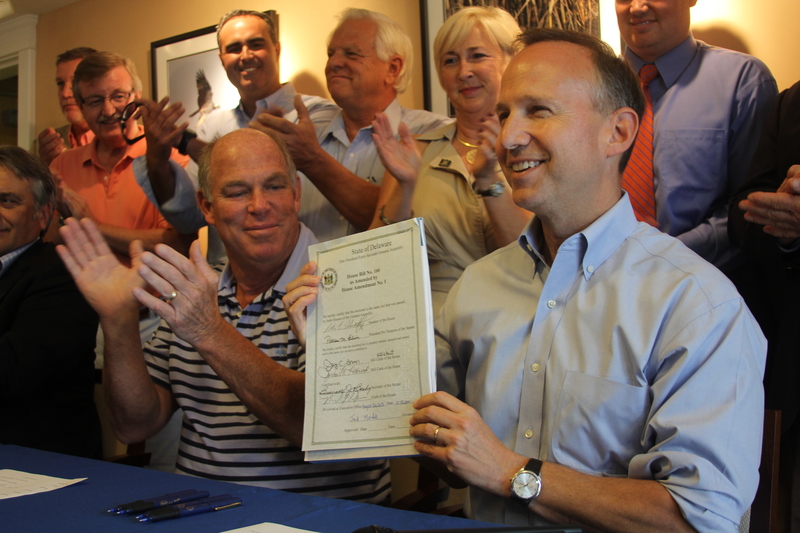Oyster aquaculture received an official stamp of approval Aug. 28 as Gov. Jack Markell signed a bill bringing back oyster harvesting to the Inland Bays.
“Delaware used to be an oyster powerhouse and I'm optimistic we can return to that,” said Chris Bason, executive director of the Center for the Inland Bays.
Environmentalists, conservationists and politicians packed the CIB facility near the Indian River Inlet to watch Markell sign the bill, which took about 14 months to develop.
Although the bill specifically mentions shellfish aquaculture, the focus has been on oysters from the beginning. Hard clamming aquaculture eventually may be added to commercial clamming that currently operates within the Inland Bays.
A group of stakeholders, dubbed the Tiger Team, gave themselves a year to bring legislators from both sides of the aisles together in support of oyster aquaculture.
Markell noted the bipartisan effort before signing the bill.
“It's more about what we can do working together to make Delaware better,” he said.
Rep. Pete Schwartzkopf, D-Rehoboth Beach, the bill's sponsor, said the benefits of shellfish aquaculture are two-fold: Jobs and nutrient removal from the bays.
“I supported this early and supported it hard and let it be known throughout the state that we wanted it,” he said.
According to information provided by CIB, the bill allows shellfish harvesting on 261 acres of Rehoboth Bay, 125 acres of Indian River Bay and 227 acres of Little Assawoman Bay. The total allowable acreage for shellfish aquaculture is five percent of the total Inland Bays area.
During the 19th century, Delaware's oyster harvest was profitable – often referred to as white gold of Delaware. Disease in the 1960s, however, destroyed much of the oyster crop, and leases for harvesting reverted to the state.
Now, Delaware officials are banking on the success of shellfish aquaculture in others states by bringing it back to area waters. Although clams make up the bulk of shellfish industry harvests, a CIB report states most of the recent growth is from oysters.
In 2011, Rhode Island leased 160 acres for shellfish aquaculture. Gross revenue was $2.5 million; the industry provided 84 full- and part-time jobs.
Officials estimate shellfish aquaculture could have a broad range of gross revenue from $2.4 to $11.2 million based on leased area the size of Rhode Island's. Total economic impact for the region could be $6 to $28 million.
“My dream is to walk into a restaurant and see Rehoboth Bay oysters, Indian River oysters on the menu,” said Secretary of Agriculture Ed Kee.
Besides the potential economic benefit, oysters would help improve water quality of the Inland Bays, according to environmental benefits provided by the CIB.
Nutrient pollution continues to be the number one problem for Delaware's Inland Bays, Bason said. While aquaculture will not solve all the problems of the bays, he said, the nutrient removal capacity of shellfish could significantly improve water quality.
An oyster filters 20-50 gallons of water a day removing algae-causing nutrients and improving water clarity. One acre of leased bottom can produce about 750,000 oysters that could filter 15-40 million gallons of water a day.
With the passage of the bill, it is now up to the Department of Natural Resources and Environmental Control to develop regulations to administer the program and establish how leases will work.
Dave Saveikis, director of the Division of Fish and Wildlife, said DNREC will review existing uses within the bays such as boating, fishing and commercial clamming to make sure oyster aquaculture is compatible with them.
Oysters are definitely an innovative way to improve water clarity, Saveikis said.
“Habitat will improve, and so will the local economy,” he said.
Melissa Steele is a staff writer covering the state Legislature, government and police. Her newspaper career spans more than 30 years and includes working for the Delaware State News, Burlington County Times, The News Journal, Dover Post and Milford Beacon before coming to the Cape Gazette in 2012. Her work has received numerous awards, most notably a Pulitzer Prize-adjudicated investigative piece, and a runner-up for the MDDC James S. Keat Freedom of Information Award.


























































